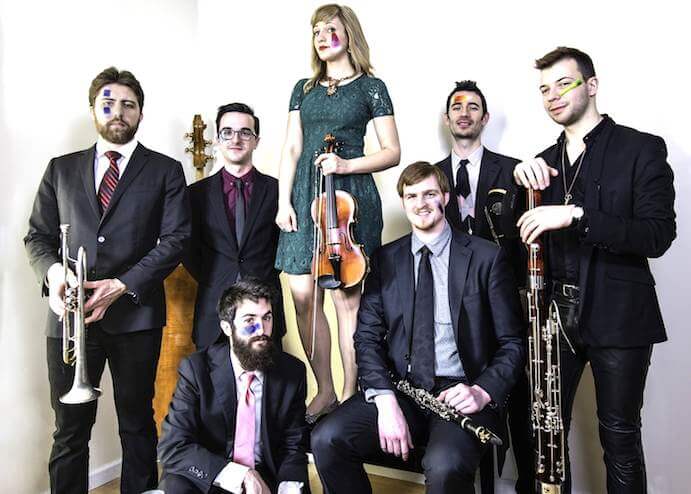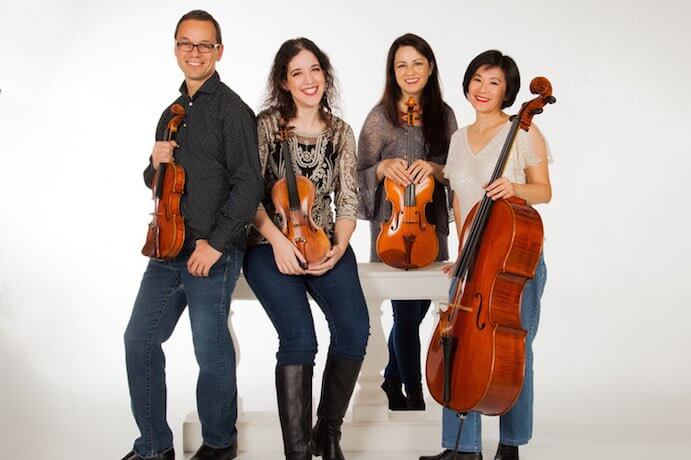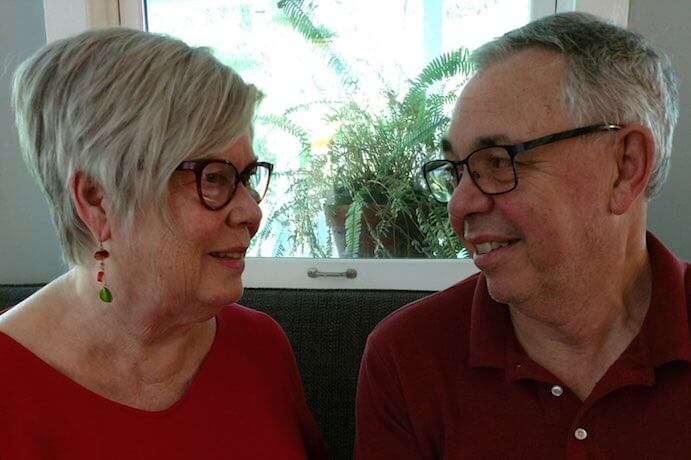Columbus, Ohio tends not to attract much hype, despite being among the Midwest’s few fast-growing metropolitan areas. Advocates of the city hope to put it on the map, and their ranks include champions of new music such as Jack and Zoe Johnstone, founders of the Johnstone Fund for New Music. The Short North, Columbus’s longtime arts district, serves as home to Jack and Zoe. Their fund supports performances by both local groups and out-of-town artists with Central Ohio connections. Recent funded events include concerts by Quince and Unheard-of//Ensemble, as well as locals such as BalletMet and the Columbus Symphony. Administered by the Columbus Foundation, the Fund turns ten years old this fall, having made dozens of projects possible. Zoe Johnstone, a pianist, composer, and arts advocate, has summarized its purpose concisely: “we fund energy.”
The stated mission of the Johnstone Fund is “to expand the audience for new music in Central Ohio.” Have you noticed expansions and changes in the audiences that come out for these performances?
Ten years ago, we would have characterized the audience for new music as small and specialized. At that time, new music could be heard mainly in the concert halls of the many fine universities in the area (Ohio State, Capital, Otterbein, Ohio Wesleyan, Denison, Columbus State, etc.), and to a lesser extent, among the professional ensembles in Columbus. Pro Musica Chamber Orchestra has always stood out as an example of a group firmly committed to commissioning and performing new music, but ten years ago, not many other organizations were following suit.
Over the last ten years, there has been a tremendous flowering of opportunities to hear new music in Central Ohio, along with a diversification of audiences and a growing willingness to explore a wider variety of music. We think this expanding audience is largely related to the growing number of venues presenting new music performances, ranging from internationally-known arts institutions like the Wexner Center to local startups like Wild Goose Creative. These venues (and others like them) increase the visibility of new music in Columbus, making it more accessible and discoverable to a wider number of people. Columbus also has a number of bars and restaurants presenting new music concerts, including Natalie’s Coal Fired Pizza and Live Music and the Seventh Son Brewing Company, which helps reach even more listeners that might not have otherwise sought this music out in the first place.
Of course, this growth is also directly related to the wonderful musicians and composers in our region, as well. Organizations like the previously mentioned Pro Musica Chamber Orchestra, a variety of regional orchestras, CODE, the Carpe Diem String Quartet, the Mark Lomax Quartet, and so many more are consistently presenting new music in Columbus. We are particularly fond of the Columbus Symphony’s ‘Happy Hour’ concerts, which are free concerts featuring new music presented by the Johnstone Fund for New Music in conjunction with the symphony. The next one is coming up on January 9 at the Ohio Theater and features six works by composers who have recently graduated from colleges in Ohio.
Our goal is to support new music in all venues for all audiences, whether played by professional musicians for seasoned audiences, or by amateur groups played for an audience with fresh ears. If we can help bring new music and receptive audiences together, we have satisfied our mission.

Mark Lomax Quartet
Upcoming performances include concerts featuring Exceptet, the Mark Lomax Quartet, the Columbus Symphony, and UCelli–a diverse array of groups. Are there any hard limits to your expansive definition of new music, whether by genre, instrumentation, or any other criteria?
We don’t set many limits on our definition of new music. Our main expectation is that the music we present reflects the forward-thinking identity of the series, challenging players and audiences to explore the music of our time. From an aesthetic standpoint, it is hard to describe our criteria, simply because we’re interested in so many different people. Of course, sometimes we make mistakes, but these are the driving motivations behind our programming.
We have found over time that there are three general approaches to finding projects to support.
- Ensembles in Central Ohio bring ideas to us and our Board of Advisors. Sometimes these are fully developed programs; other times they are notions about commissioning a new work, about a venue with an established audience, or an ensemble willing to challenge itself.
- We invite musicians, composers, and ensembles to come up with programs based on ideas that we present to them. These range from established professional ensembles to regional semi-professional groups, to community organizations. Our decisions for these groups are based on the degree of challenge presented by the program relative to the intended audience and level of musical skill of the ensemble.
- Out-of-town chamber ensembles approach us, often at the recommendation of musicians we know and trust, about appearing on our series New Music at Short North Stage.
We like to support the commissioning and performance of new works. We also will consider the performance of prominent works from the 20th century that, along with their historical significance, reflect a contemporary spirit. We like to work collaboratively in ways that foster new ideas across genres, from composers, classical ensembles, jazz and blues musicians, poets, dancers, film makers, playwrights, and theater producers.

Exceptet
The Fund’s guidelines stipulate that performances should welcome all, last an hour without intermission, and be free if possible. Does the power of patrons and philanthropists come with a responsibility to foster a more welcoming, accessible culture in the art-music world?
Musicians give a gift of creativity to their audiences and their communities. Likewise, audiences give a gift of appreciation to composers and performers. This creates an energy like a forest fire—you can’t contain it once it starts. You just need a spark to bring musicians and audiences together. This type of energy comes from the entire community—an amateur musician picking up the cello after her children are grown; an octogenarian arranging a string program for public school students; a professional violist starting a community orchestra; a college teacher giving music lessons to poor kids; a high school teacher playing a gig with his more famous student. Everyone loves new music, but they may not quite know it yet. The small contribution we make is to give more people the chance to realize what they have been missing.
As patrons of new music, we certainly feel it’s our responsibility to create an open, welcoming environment at our concerts. To build a larger, more diverse audience for new music (both in and outside of Columbus), concerts need to be presented in a way where everyone is welcome. By using non-traditional venues, presenting affordable (often free) concerts, and curating an aesthetically diverse series, we hope to promote cross-pollination between different audiences while shedding some of the ivory-tower-ness that can be associated with this sort of music.
As your project turns ten, are you expanding your operations and seeking out new collaborators, or staying focused and maintaining current partnerships?
In a way, the new collaborators are finding us. We try to be open to anyone and everyone, with the only requirements being quality, creativity, and a focus on contemporary music. Our advisors help us make the right decisions. We discuss, tussle, argue, mediate, and generally come up with the best advice and the right choices. We also develop long-lasting connections to composers and performers as they disperse around the country. These connections help us to become aware of interesting currents in new music and help people from around the country find us.
Furthermore, the Columbus Foundation has been a godsend. They constantly coach us on how to improve, how to be open without being easy, how to say no, and how to say maybe. They take the administrative burden of philanthropy off our shoulders, so that we can focus on promoting new music.

Carpe Diem String Quartet
I live in Cleveland, which is gaining ground in new-music initiatives but still experiencing net losses in population each year. Columbus, by contrast, is growing faster than many larger and more talked-about cities. What are your hopes for Columbus, and for its new music scene, in the coming five or ten years?
First of all, we love Cleveland, its brilliant orchestra and musical institutions, and its new music scene. Columbus is a city that struggles to support its major arts institutions, but it thrives on the initiatives of individuals and small groups. It doesn’t get in the way of people doing interesting things, and it does its best to support diverse communities and neighborhoods. The Columbus Foundation, the Greater Columbus Arts Council, the Columbus Cultural Arts Center, Ohio Arts Council, and many local philanthropies do an excellent job of supporting individuals, small groups, and start-up organizations. Thanks to this grass-roots approach, we hope that in five years, the new music scene in Columbus will have even more of the energy and creativity that mark it today. Boundless energy is a wonderful thing.
For the Johnstone Fund specifically, we are excited about the expanding relationships we are building with composers and music schools around Ohio (BGSU, Kent State, and CCM, just to name a few). There’s such a wealth of creativity in our state, and we want to get everyone talking and working together. One current example of this is ‘The Big SCORE,’ a program of newly commissioned works that pair six Ohio based composers with six Ohio based writers. This is our biggest commissioning effort yet, and we’re excited for them to be premiered by the musicians of CODE and Sunday at Central at the Short North Stage in Columbus on 5/22/19.


















